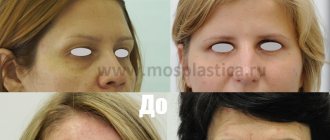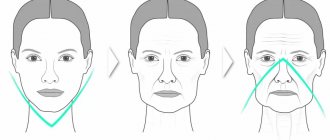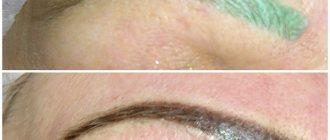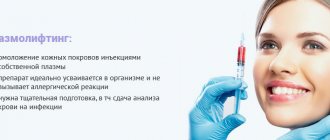IndicationsEndoscopic correctionAdvantagesForehead correction with endotinsSpecifics of the recovery period
Possible complications Reviews Questions and answers Who to sign up for Prices
Local facial plastic surgery is gaining increasing popularity. Unlike total circumferential lifts, they are completely safe and do not require long-term rehabilitation. To correct the upper area of the face, we offer several techniques, which are selected based on individual indications.
Indications for brow lift
Aesthetic surgeons recommend lifting the upper part of the face:
- when sagging, sagging skin appears (including on the temples);
- drooping eyebrow line (both along the entire length and in the inner or outer part);
- downward displacement of the outer corners of the eyes;
- pronounced wrinkles, folds localized in the forehead and bridge of the nose;
- age-related ptosis, tissue deformation or genetically low eyebrows and heavy eyelids;
- facial network of wrinkles around the eyes (it is effectively eliminated when using the temporal lifting technique).
The main goals of plastic surgery in the upper third of the face are:
- Forehead lift
- Eyebrow lifting
- Eyelid correction
Today, traditional “open” plastic surgery is gradually becoming a thing of the past. They are being replaced by complex minimally invasive interventions that can produce better results while simultaneously reducing risks and reducing the duration of the rehabilitation period.
Let's look at the most promising modern methods of anti-aging plastic surgery of the upper face, which allow you to tighten the forehead, lift the eyebrows and rejuvenate the look by removing the sagging of the upper and/or lower eyelids.
Need a consultation?
Forehead and eyelid lift - a complex minimally invasive surgery
All photos of lifting results
Patients often do not realize how drooping eyebrows age them; they give their face a tired, angry or perpetually dissatisfied look. Often people turn to a plastic surgeon for blepharoplasty, although another operation is required - a forehead lift and eyebrow lift.
Go to the mirror and try to pull your skin up a little. Have you noticed how your eyes have changed, your eyelids have stopped drooping, and your face has acquired a more optimistic expression? This is exactly the effect that forehead plastic surgery gives.
Typically, the need for this operation arises in patients over 35 years of age (forehead and eyebrow lifts are popular not only among women, but also among men), but in some cases (for example, if you have naturally heavy eyelids or deep-set eyes), this procedure is resorted to and very young people.
Often eyebrow and eyelid correction is performed as one complex operation. This approach has its advantages:
- Simultaneous lifting gives the most complete and natural effect, as all signs of aging are eliminated without exception.
- This operation can be done in a minimally invasive manner without unnecessary incisions, the risk of nerve damage and the need for long-term rehabilitation. After a week, the patient can return to his normal lifestyle!
How is a brow lift with simultaneous eyelid correction performed?
Photo: Dr. Bely’s original technique is used.
Upper blepharoplasty and brow lift are performed through one small incision in the crease of the upper eyelid. In terms of complexity and trauma, this complex plastic surgery is practically no different from classic eyelid lifting and at the same time is much less invasive than traditional surgical correction of the forehead, which is done through a long incision along the hairline. Of course, a complex eyelid and eyebrow lift operation is much simpler and easier than two separate ones (we mean blepharoplasty and forehead lift).
Postoperative period. What should the patient prepare for?
Like any complex operation, forehead plastic surgery (see photo) has a number of not very pleasant consequences. They are not so much painful as aesthetically unattractive:
- a slight heaviness appears in the eye area. This occurs because the frontal tissues swell;
- during the first three to four months the patient experiences decreased sensitivity, but over time it returns to normal;
- discomfort, pain for a number of days after the operation.
Any disruption of natural processes in the body, and especially such a procedure, cannot pass without leaving a trace. It will take time and effort to recover. You need to be prepared in advance for the fact that your lifestyle will change noticeably and you may even have to not go to work during the first postoperative month.
Strictly follow all the recommendations of your attending physician and come to the clinic as often as possible to undergo examinations and receive advice.
Endoscopic correction of forehead and eyebrows
If eyelid correction is not required, an endoscopic forehead lift is performed. This method is also called “no-incision surgery”, since the intervention is carried out through punctures of a few millimeters and leaves virtually no traces. The endoscopic method at one time became a real breakthrough in facial plastic surgery, and now this procedure is a common daily practice, which has almost completely replaced the classic method of open surgery with a bicoronal incision, which leaves a long scar along the hair growth from ear to ear.
As we have already said, an endoscopic forehead lift is performed without classic incisions and excision of excess skin tissue. Instead, plastic surgeons perform detachment surgery and then move and fix the soft tissue in a higher position. Small punctures through which endoscopic instruments are inserted are placed in the scalp, so there is no need to worry about noticeable scars.
Despite the fact that endoscopic surgery is performed without incisions, the surgeon has a clear view of everything that is happening in the surgical field thanks to a tiny camera that is inserted through a separate puncture. The image is enlarged and transferred to a large screen.
Thanks to the advent of endoscopic techniques, it was possible not only to completely rid the patient of scars and reduce the duration of the recovery period, but also to reduce the risks of postoperative complications such as innervation and vascularization disorders.
Who is this procedure contraindicated for?
- persons under 18 years of age;
- patients suffering from cancer;
- patients who experience inflammatory processes in the tissues involved in the operation;
- people who have impaired blood clotting, as well as those who take medications that reduce it;
- patients with diabetes mellitus, as well as various infectious diseases.
Before you decide to have surgery, you will need to meet with the surgeon (if necessary, there may be several such conversations). Discuss with your doctor all possible options for carrying out the procedure, study in detail the theoretical material that the specialist will recommend to you. Talk to people who have already had positive experiences with similar plastic interventions. Complete all necessary examinations and arrange for a simulation.
Forehead correction with endotins
Endoscopic forehead lift surgery can be performed using endotins. These are thin, absorbable strips equipped with sharp teeth to secure tissue (see detailed information on the use of endotins in facial plastic surgery).
Endotins make it possible to solve the problem of reliable and uniform tissue fixation without overload and the risk of tearing inherent in point fixation. Otherwise, the operation is the same as a regular endoscopic forehead lift.
How does it go?
As with any such surgery, to reduce any area, you will need to either move individual bones or remove some parts of them. As for the required expansion of the area, it occurs through one’s own tissues or through the use of silicone implants.
Plastic surgery on the forehead is performed in two versions. In the first case, the frontal bone is “transferred” slightly back. In the second, the frontal bone, on the contrary, is pushed forward. In this case, the surgeon does not touch the intracranial part of the head. If the frontal bone needs to be pushed forward, the doctor will use an implant.
It is important that during this procedure the specialist focuses not only on the center of the forehead, but on the entire face. It is necessary to take into account the jawline, the location of the nose and cheekbones in order to create uniform proportions.
Specifics of the recovery period
The duration of rehabilitation, the rate of subsidence of swelling and hematomas depend on the technique used, the volume and complexity of the correction. On average, soft tissue recovery takes 2 weeks. Loss of sensitivity may persist for up to 3 weeks, but it goes away on its own without additional treatment.
If the surgical approach was carried out using incisions and subsequent suturing of the wound, the sutures are usually removed after 10 days. Limitations after surgical brow lift (within 1 month) are:
- intense sports, increased physical activity;
- insolation;
- alcohol, smoking;
- thermal procedures and mechanical effects on the operated area.
Sometimes a special elastic tape is applied to the correction area (for up to 3 weeks) to fix the displaced tissues and secured in a new position. Individually, according to indications, medicinal antibacterial therapy and painkillers may be prescribed to prevent inflammatory lesions and relieve pain.
Who is suitable for forehead lift?
It is not entirely true that you should start thinking about a forehead lift after reaching a certain age. Each organism lives according to its own biological clock - for some, the aging process begins earlier, for others later. Therefore, the indication for surgery should not be the numbers in the passport, but the condition of the upper part of the face.
The basis for a forehead and eyebrow lift may be:
- the presence of small and deep wrinkles on the forehead;
- deep eyebrow folds;
- drooping corners of the eyes, “crow’s feet” around the eyes;
- drooping of the outer ends of the eyebrows;
- eyebrow asymmetry;
- overhanging tissue of the subeyebrow;
- low forehead line.
Any plastic surgery has a number of contraindications. So, a waiver from the operation can be:
- cardiovascular diseases;
- malignant formations;
- bleeding disorders;
- diabetes;
- infections;
- pregnancy and lactation.
The key to every successful operation lies in the patient’s confidence in the professional skill and aesthetically similar views of the plastic surgeon. The multidisciplinary clinic “MedicCity” employs attentive and highly professional doctors. Visit our plastic surgeon for a consultation and see for yourself!
Possible complications after a brow lift
Negative postoperative consequences are usually associated with insufficient qualifications of the doctor who performed the correction, or patients’ failure to comply with recommendations during rehabilitation. May occur:
- feeling of pain, numbness in the forehead area;
- change in symmetry, unnaturalness of facial movements;
- damage to nerve endings;
- hair loss and impaired hair growth;
- scarring or infection of the suture.
When surgical lifting is performed correctly, the percentage of complications is minimal (about 1%), and the aesthetic result (a rejuvenated, open face) completely transforms the patient.
Forehead lift, eyebrow lifting and eyelid correction are available not only to Moscow residents. Patients come to us from Perm, Volgograd, Rostov-on-Don, Voronezh, Yekaterinburg, Kazan, Krasnoyarsk, Nizhny Novgorod, Novosibirsk, Omsk, Samara, Ufa, Chelyabinsk and other cities throughout Russia.
Forehead, eyebrow and eyelid lifts can be performed in various ways in our clinic. The specific technique is chosen by the plastic surgeon based on existing indications and taking into account the wishes of the patient. These operations at the DOCTORPLASTIC clinic are performed not only by leading Russian facial plastic specialists, but also by such stars of world plastic surgery as Professor Samuelsson, President of the Swedish Association of Plastic Surgeons.
Preparation
After consultation to determine the price of frontal surgery of the forehead or brow ridges, preoperative preparation is necessary. In addition to all tests, consultations with a therapist, ENT doctor and anesthesiologist, it is necessary to perform radiographs in lateral and direct projections. They help the surgeon evaluate the shape of the sinuses, their true size, the thickness of the bony septa and the location of the anatomical structures.
The peculiarities of frontoplasty are that the doctor has clear anatomical points, works in the intervention area without affecting the circulatory areas and nerves, which helps to recover faster. Access along the area of hair growth helps to hide the future scar, and detachments of deep layers of tissue mask swelling and possible hematomas.
Post-procedure care and recommendations
After plastic surgery, a person needs about 3-4 weeks to recover. In the case of the injection method, it is enough not to touch the puncture sites with your hands, not to take hot baths and not to be in the sun. Recovery occurs within a week.
During surgery there will be swelling and hematomas, but this will all go away in a couple of weeks. It is at this time that the stitches are removed. In certain parts of the head, sensitivity disappears, which appears after 1-3 months. For quick rehabilitation, you need to take painkillers and anti-inflammatory pills.
What should I expect after surgery?
Immediately after surgery, swelling and bruising may appear in the eyebrow area and forehead, which may persist until the 10th day after surgery. The first night after surgery, you should sleep with your head elevated. You can apply ice to your face to reduce swelling. You may be worried about slight discomfort in the surgical area, which quickly goes away when you take painkillers prescribed by your doctor. The dressing and drains (if required) are usually removed within the first few days after surgery. After a few days, the doctor will allow you to shower and wash your hair. As the healing process begins, you may feel numbness and itching where the skin was cut. For most patients, the recovery period after a traditional brow lift is about 2 weeks. After endoscopic surgery, recovery is often faster. During this period, you may feel the ENDOTINE Forehead device under your skin and experience increased sensitivity in this area until the bioabsorbable material from which the device is made is absorbed by the body.
"I think it's worth paying a little more for Endotine ...Especially considering the existing alternatives"
Pamela, 42 years old
Most patients are very pleased with how younger they look after a brow lift. Although the final effect may sometimes take weeks or months to become noticeable, you will likely agree that the results were worth the wait.
The duration of the effects of surgery varies from person to person. It depends on many factors, including heredity and lifestyle. Although you will start to look younger, remember that the aging process cannot be stopped. It is likely that in the future you will decide in favor of another plastic surgery.
Contraindications
Plastic surgery has several limitations:
- Poor blood clotting.
- Pregnancy and lactation.
- Diseases of the endocrine system.
- Acute diseases.
- Infectious diseases and inflammatory processes.
- Hypertension.
- Oncology.
You can consult, make an appointment and find out the price of forehead surgery by calling KDS Clinic 7(495)-121-04-83. The clinic employs experienced, qualified specialists who will give advice and, if necessary, perform high-quality surgery.











